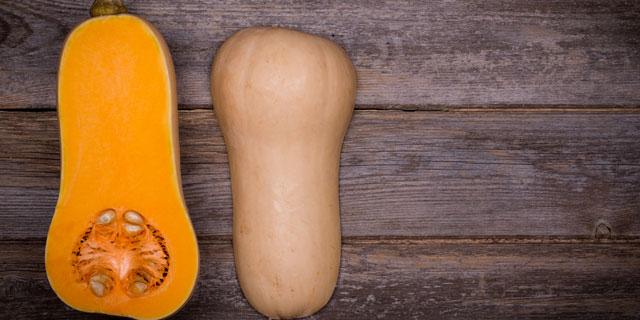It’s time for our beloved dark, leafy greens to make room for another powerhouse vegetable – butternut squash. This squash is known for its sweet flavor and creamy, buttery texture; hence its name.
Most enjoy butternut squash in soups and stews during cold and flu season, and for good reason. One of the richest sources of omega-3’s, alpha-carotene, and beta-carotene, butternut squash helps support a strong and healthy immune system. Covering almost half of your daily need of Vitamin C, with almost 3 grams of fiber and 1.5 grams of protein per 65 calorie cup, it’s a staple in the Latin kitchen. Include it in your diet before, after and during sniffle season to enjoy all its benefits for your body and your taste buds!
How do I pick the best butternut squash?
To select the best butternut squash, first look at the skin. It should be evenly colored and dull with no sheen, shine, or gloss. It should also be hard and free of any scrapes, nicks, or cuts. The squash should be heavy for its size and as a whole should be very firm to the touch. From end to end, look for any indication of decay including mold, discoloration, or soft spots. If you find any of these, move on to another squash. It may seem tedious, but finding a perfect specimen is worth it. If you can, buy organic to avoid any pesticides.
What can I make with butternut squash?
Butternut squash can be broiled, boiled, steamed, sautéed, and baked. Slightly sweet with a smooth texture, it works well in sweet and savory recipes from breakfast through dessert. Try butternut squash pancakes drizzled with agave and topped with roasted seeds; sauté it with pasta and chorizo for a hearty entree; or puree it with chèvre for a twist on mashed potatoes. From simply roasted with salt and pepper to mashed and used as a filling in fresh cilantro pasta, the possibilities are endless!
To prep, simply run squash under cool running water then peel off the rind. Cut the top and bottom off of the squash and discard them. Then, cut the squash in half between the neck and the bulb. Cut each piece in half lengthwise, then remove the seeds from the bulb and set aside. Proceed to slice, dice, or cube squash as desired. The seeds can also be cleaned and roasted for a hearty snack!
Butternut squash can be stored for up to six months in a cool, dark, and dry place. Once cut, the squash should be covered in plastic wrap and stored in the refrigerator where it will remain fresh for two to three days. For longer storage, rinse and cut squash into cubes then freeze for up to a year.
Recipes to try include: Whole Wheat Squash Empanaditas, Butternut Squash and Black Bean Soup, and Kale and Squash Gratin.


![Making Mealtime Matter with La Familia: Easy Sofrito [Video]](https://thelatinkitchen.com/wp-content/uploads/2015/10/sofrito-shutterstock__0-500x383.jpg)
![Easy Latin Smoothies: Goji Berry Smoothie [Video]](https://thelatinkitchen.com/wp-content/uploads/2015/12/goji_berry-shutterstock_-500x383.jpg)
















![Fun and Fast Recipes: Fiesta Cabbage Salad [Video]](https://thelatinkitchen.com/wp-content/uploads/2015/11/fiesta_cabbage_slaw-shutterstock_-500x383.jpg)









